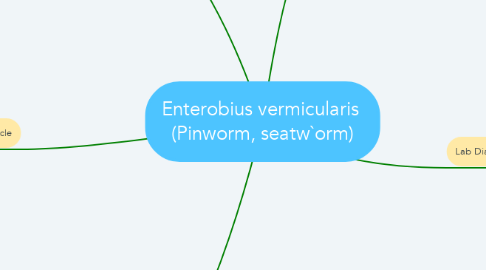Enterobius vermicularis (Pinworm, seatw`orm)
by Christine Padilla

1. Treatment
1.1. -Albendazole - Mebendazole -Pyrantel pamoate
2. Life Cycle
2.1. Life cycle
2.1.1. 1. Ingestion of infective eggs 2. Eggs migrate through the digestive tract to small intestine (hatch and release young larvae) 3. Larvae matures to adult forms 4. Adult worms resides in the colon 5. Mating of adult male and female. Female worms migrate outside the body to the perianal region and deposits eggs 6. After 4-6 hours of incubation, infective status achieved! 7. Ingestion of these infective eggs initiates a new cycle A. - Infective pinworm eggs that migrate back into the host body, develop and reproduce rather than being dislodged. B. -Infected individuals may reinfect themselves - Infective pinworms eggs are ingested via had-to-mouth contamination
2.2. Host: Human
2.3. *Once apart from the host, the infective eggs may take up residence in a number of locations, including dust, sandboxes, linens and clothing.*
2.4. *eggs may become airborne*
2.5. a. Retroinfection
2.6. b. Autoinfection
3. Clinical Symptoms
3.1. Clinical Symptoms a. Asymptomatic b. Entrobiasis: pinworm infection A. - E.vermicualris infection are asymptomatic B. Common symptoms of patients: - intense itching - inflammation of the anal and/or vaginal areas - intestinal irritation - mild nausea - vomitting - irritability - difficulty in sleeping - ulcers - intestinal inflammation - abdominal pain
4. Morphology
4.1. Morphology a. Eggs (consists of developing larva) b. Adults A. Parameter: Description Size: 48-60 um long, 20-35 um wide Shape: oval, one-side flattened, “D” shaped Embryo: stage of development varies; may be unembryonated (unfertilized), embryonated (fertilized), mature Shell: double-layered, thick, colorless B. Parameter: Description Length: 7-12mm (F) 2-4mm (M) Width: up to 0.5mm (F) </= 0.3mm (M) Color: Yellowish-white Tail: pointed; resembles pinhead
5. Lab Diagnosis
5.1. Specimen of choice: - Cellophane tape preparation (perianal) - Eggs and/or adult females may be recovered in stool samples (rare occasions) *multiple samples may be required to confirm the presence of a light infection as well as to determine that a patient is free of infection*



